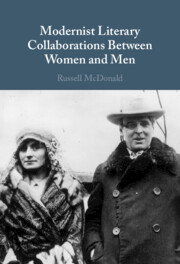Book contents
- Modernist Literary Collaborations Between Women and Men
- Modernist Literary Collaborations Between Women and Men
- Copyright page
- Dedication
- Contents
- Figures
- Acknowledgments
- Abbreviations
- Introduction
- Chapter 1 Imagining Two as One: Collaboration and the Discourse of Sex Relations in Early Modernism
- Chapter 2 The Discord Aesthetic in D. H. Lawrence’s Collaborations with Women
- Chapter 3 “The Fight to Be Affectionate”: Textual Intimacy and the Drive to Animate Marriage
- Chapter 4 “The Yolk and White of the One Shell”: Modernism’s Androgynous Textual Bodies
- Chapter 5 Conclusion: Being a Genius Together
- Notes
- Works Cited
- Index
Chapter 4 - “The Yolk and White of the One Shell”: Modernism’s Androgynous Textual Bodies
Published online by Cambridge University Press: 20 October 2022
- Modernist Literary Collaborations Between Women and Men
- Modernist Literary Collaborations Between Women and Men
- Copyright page
- Dedication
- Contents
- Figures
- Acknowledgments
- Abbreviations
- Introduction
- Chapter 1 Imagining Two as One: Collaboration and the Discourse of Sex Relations in Early Modernism
- Chapter 2 The Discord Aesthetic in D. H. Lawrence’s Collaborations with Women
- Chapter 3 “The Fight to Be Affectionate”: Textual Intimacy and the Drive to Animate Marriage
- Chapter 4 “The Yolk and White of the One Shell”: Modernism’s Androgynous Textual Bodies
- Chapter 5 Conclusion: Being a Genius Together
- Notes
- Works Cited
- Index
Summary
Chapter 4 examines three instances where the juxtaposition of a man’s and a woman’s textual contributions aims to satisfy the modernist desire for androgyny. W. B. Yeats’s interest in androgyny is expressed through iconography that the artist Althea Gyles employed in her designs for the covers of his books The Secret Rose (1897) and Poems (1899), but it is also embodied by the material texts of those books themselves, which bring together a man’s words with a woman’s images. A similar collaborative dynamic is apparent in Marianne Moore’s 1936 volume The Pangolin and Other Verse, where poems that explore seemingly impossible meetings of difference work together with illustrations by the male artist George Plank to convey an androgynous vision. The chapter concludes by turning to the modernist writer most closely associated with androgyny, Virginia Woolf. Drawing on the famous image from A Room of One’s Own of a man and woman stepping into a taxi that spurs Woolf to write of the androgynous mind, I argue that Woolf’s dialogic “meeting” with her husband Leonard in their 1917 Hogarth Press volume Two Stories reflects her desire to achieve androgyny through cross-sex collaboration.
Keywords
- Type
- Chapter
- Information
- Modernist Literary Collaborations between Women and Men , pp. 160 - 204Publisher: Cambridge University PressPrint publication year: 2022

